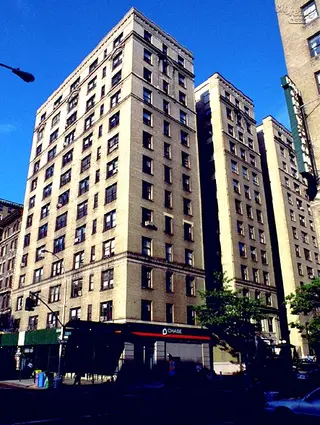 Carter Horsley
Carter HorsleyDec 23, 2011
Carter's Review
This attractive, 13-story apartment building at 215 West 91st Street was designed by Schwarz & Gross in 1917.
It is a cooperative with 89 apartments. It is known as the De Soto and also has an address of 2460 Broadway.
There used to a local subway station at this corner which is a block-and-half west of Trinity School, one of the city's oldest.
The building has a an impressive, large lobby, a three-story base, some decorative balconies, two bandcourses, and a two-story entrance surround with four globular sconces and protruding air-conditioners.
In his April 25, 1991 "Streetscapes" column in The New York Times, Christopher Gray noted that "The terra-cotta cornice of the DeSoto, at 215 West 91st Street, was removed in 1983, but restored in 1986. A similar building at 215 West 75th Street had its cornice removed earlier this year, but is replacing it fiberglass."
"When the beautiful 85-year-old cornice was ripped off the Allenhurst apartment building at the southeast corner of 100th street and Broadway this year, anyone familiar with New York city s old buidings would have drawn the same conclusion: an unfavorable façade inspection under Local Law 10 led to the 'scalping,' leaving a bare stucco scar along the top - just the kind of action to confirm preservationists' fears of the 1980 law. An alternative interpretation is that Local Law 10 is not the problem, but the solution for how to maintain an aging cityscape, an idea supported by a study of the actual incidence of such façade stripping....As for the Allenhurst's cornice - well, that is a bit of a surprise, too.
"Local Law 10 was passed after Grace Gold, a Barnard College student, was killed in 1979 by a piece of terra cotta that fell from a 1912 apartment house at 115th Street and Broadway. Irwin Fruchtman, then commissioner of the Department of Buildings, was concerned about the increasing age of New York's buildings and had already proposed a façade inspection measure. The law generally requires insprections of façades of buildings taller than six stories at least every three years.
"Having owners look at their buildings on a periodic bases, that's what's going to preserve them,' says Mr. Fruchtman, now in private practice as an engineer. By the early 80s, it was easy to find façades that had been effectively mutilated, and a rash of articles appear carried complaints from the preservation community that directly blamed Local Law 10.
"The unstated presumption was that without Local Law 10, cornices and balconies all over the city would survive intact.
"However, a building-by-building survey on the West Side indicates that Local Law 10 did not begin the process, but came in at the middle. On Broadway, West End and Riverside Drive, between 70th and 110th Streets, there are 207 tall buildings. From a street survey, 46 may once have had balconies or cornices. Just when they were removed is hard to ascertain, since removing a cornice or balcony does not, generally, require a building permit. But working with post-World War II photographs and the first round of inspection documents under Local Law 10, it is clear that cornice- and balcony-stripping became along before 1980.
"Of the 46 buildings, 17 were definitely stripped before 1987, like the Dorilton, at 71st and Broadway, which lost a major cornice sometime after 1945. From 1980 to 1985, 12 buildings in the study area were indeed scalped, like the Mayflower Hotel on Central Park West between 61st and 62nd Streets. Since 1985, only 7 buildings have had balconies or cornices removed. Of the remaining 10 buildings, either the dates of the stripping cannot be determined, or possibly nothing was actually removed. The stripping of one-third of the study group before Local Law 10 suggests what conservation professionals know; most of New york city's older buildings were neglected for decades, except for the occasional smear of roofing tar to temporarily cure a leak. Without real attention, their most exposed (and hard to reach) elements began to fail.
"The 12 strippings from 1980 through 1985, followed by 7 since, indicate that there was indeed a burst of stripping in the first years but that the rate has declined. Thousands of other buildings have been examined under Local Law 10 by engineers who recommended minor maintenance to help preserve them. The law itself has created a cadre of consultants and contractors are more familiar with preservation than their colleagues of a generation ago. Indeed, several of what are counted as strippings in the study are really not.
"As for the Allenhurst, the last Local Law 10 report, filed in November 1991, did cite several problems with the masonry, but called for no work on the cornice except repairing a hole in one section. But Yahe Tiryakian, a spokesman for the Department of Buildings, said a large part of the cornice was blown off in the December storm and the owner simply decided to remove the rest, Local Law 10 had nothing to do with it."

- Co-op built in 1917
- 1 apartment currently for sale ($1.295M)
- Located in Broadway Corridor
- 89 total apartments 89 total apartments
- 10 recent sales ($319.9K to $2.1M)
- Doorman
 6sqft delivers the latest on real estate, architecture, and design, straight from New York City.
6sqft delivers the latest on real estate, architecture, and design, straight from New York City.
